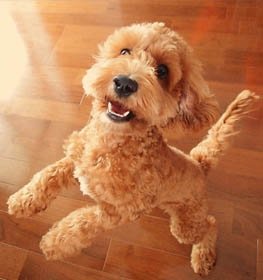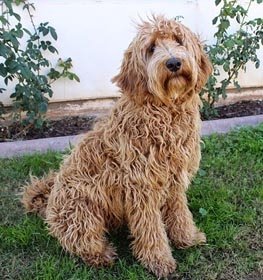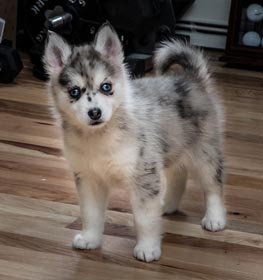Puggle Information & Dog Breed Facts
Collection of all the general dog breed info about Puggle so you can get to know the breed more.
| Group | Designer Dogs |
|---|---|
| Popularity Rank | 207 |
| Reviews | 5 |
| User Ratings | |
|
Compare the Puggle With Other Dogs
Select at least one dog breed to make the comparsion. | |
 | |
| Origin | |
|
Common Names & Aliases
What other names is a Puggle known by? Discover all traditional, regional and informal names used for this breed. | Beagle-Pug |
|---|---|
|
Breed Classification
What type of dog breed is a Puggle? Learn about its genetic classification and breeding category. | Cross Breed |
Photo Gallery of the Puggle Breed
|
Size Classification
What size category is a Puggle? Learn how big the Puggle breed typically grows. | Small |
|---|---|
|
Weight Statistics
How much does a Puggle weigh? Discover typical weight ranges for adult males and females of the Puggle breed. | 15-40 pounds (7-18 kg) |
|
Average Weight
What is the average weight of a Puggle? | 27.5 pounds (12.5 kg) |
|
Height
How tall is the Puggle? Puggle height: | 10-15 inches (25-38 cm) |
|
Average Height
What is the average height of a Puggle? | 12.5 inches (31.5 cm) |
|
Price Range
How much does a Puggle puppy cost? Find current market prices and factors affecting Puggle costs. | $600-$800 If you choose to purchase the Puggle, you should know that the mentioned amount of money is an average of the collected data from breeders’ sites and puppy finder places. If you have a Puggle for sale, please advertise it on a reliable website to make sure the Puggle gets to a happy place. |
|---|---|
|
Availability
How easy is it to get a Puggle? How many Puggle are there in the world? | Frequent: The Puggle is easier than average to get. Maybe there is some risk of overbreeding, as it is a popular breed. Due to its popularity, inbreeding may occur. A new study shows that inbreeding contributes to the incidence of disease and health problems. So be careful and seek the help of an experienced person or a professional, in making your decision. |
|
Intelligence Rating
How intelligent is a Puggle? Discover the Puggle's intelligence ranking and learning capabilities. | Low to average: This canine intelligence is not the brightest one. Keep in mind that if you want to teach them any tricks, they understand and memorize new commands in 40-80 repetitions. Puggle obey the first command 30% of the time or better. So if you want to have a smart dog, you might have to reconsider your choice with this breed.
The Puggle ranks below average in the intelligence ranking of dogs. |
|---|---|
|
Training Difficulty
How easy is it to train a Puggle? Learn about the Puggle's trainability and response to training methods. | A slightly harder to train than average. Puggle dogs aren't famous for their trainability. This breed needs more time and repetition to obey. It's challenging to teach them new commands, but not impossible. |
|
Watchdog Rating
How good is a Puggle as a watchdog? Learn about the Puggle's alertness and guarding instincts. | Puggle dogs are average watchdogs. If they sense something different, they will alert you, but observation isn't considered their main job.
|
|
Territorial Protection
Is a Puggle protective of its territory? Learn about the Puggle's guarding instincts and behavior. | Puggle dogs are not the best to protect their territory. Better to have the protection of your house and property supervised by others. |
|
Personality Traits
What personality does a Puggle have? Learn about characteristic Puggle temperament and behavior traits. | PlayfulIntelligentFriendlyAffectionateLoyalSocialCheerful |
|---|---|
|
Sensitivity Level
How sensitive are they? Puggle sensitivity: | Puggle dogs have an average emotional level and are not the most sensitive dog breed. Sometimes it's okay to change the daily routine, have guests and listen to loud music.
Some dogs handle moderate punishment very well, while others crumble apart at a dirty look. This breed is not affected emotionally by moderate punishment. |
|
Affection Level
How affectionate are they? Is a Puggle a good family dog? | Average: Puggle dogs are average dogs regarding their affection level. Some breeds are forthcoming and friendly, while others are independent and don't bond too closely with their owners. |
|
Social Needs
How much social interaction does the Beagle-Pug need? Puggle social needs: | Puggle dogs need for social interaction is average. This breed likes being around people or other animals, but they don't mind being left alone for a few hours either. |
|
Impulse to Wander or Roam
How likely is the Puggle to run away? Does this breed explore or wander a lot? Does Puggle roam? | Puggle dogs have high wanderlust potential, which means that this breed has a strong desire for exploring the world. Safer to walk them on a leash unless you teach them how to get back to you on command. This breed is also able to cause damage to your fence. |
|
Prey Drive
Do this canine have a strong prey drive? Does Puggle have high prey drive? | Puggle dogs have low to an average impulse to chase and catch something like a cat or any other small aminals. |
|
Barking Frequency
Does a Puggle bark a lot? Learn about typical Puggle vocalization patterns and triggers. | Average: The Puggle barks occasionally. They can change their barks depending on their emotional level and what they're trying to say. Different barks could mean the same and the same barks could have different meanings.
Top reasons for barking: protection, alarm, fear, boredom, attention-seeking, greeting, separation anxiety, compulsive barking. |
|---|---|
|
Playful Nature
How playful is a Puggle? Understand the typical play drive and energy level of the Puggle breed. | The Puggle is a playful breed. Excited barking and sometimes nipping will alert you to play. |
|
Apartment Adaptability
Can a Puggle live in an apartment? Learn about the Puggle's suitability for apartment living. | Very house-friendly dog the Puggle breed. It's good if you have a small garden where he can go out and do his business, but it's not important at all. You can get enough exercise with one or two walks a day, so keeping them indoors shouldn't be a problem. |
|
Lifestyle Adaptability
How adaptable is a Puggle to lifestyle changes? Learn about the Puggle's flexibility to new situations. | Puggle dogs adapt very well to lifestyle changes and basically all living environments. They don't mind moving from one place to another with their owner. |
|---|---|
|
Alone Time Tolerance
Can a Puggle be left alone? Learn about the Puggle's tolerance to solitude. | Just like every puppy, they are prone to panic, cry, bark, whine when they left alone by their owner. With proper socialization and quality time with the dog can solve this problem. |
|
Bite Risk Assessment
What is a Puggle biting potential? Learn about the Puggle's bite risk factors. | Low 🔽 The Puggle has a low chance of biting somebody. Top reasons for dog bite: protection, pain, excitement, herding instinct, being provoked. (Data based on the available online bite statistics.) |
|---|---|
|
Mouthing Tendency
Is a Puggle mouthy? Learn about the Puggle's tendency to use mouth during play. | Puggle dogs have an average tendency to nip, chew, playbite, or herd people. It's a common habit during puppyhood, not aggressive behavior. These "bites" don't hurt, but Puggle dogs need to be taught a good attitude. |
|
Bite Strength Rating
How strong is a Puggle bite? Learn about the Puggle's bite force measured in PSI. | Between 100 and 200 PSI 🔽 Puggle bite force: Weak. The Puggle bite force is considered weak when compared to other dog breeds. The bite force Puggle measurements usually fall below 200 PSI, making them one of the breeds with the weakest bite force. The bite force of a Puggle may be weak, but it's important to remember that any dog's bite can still be dangerous if not managed properly. Despite the bite force of Puggle being lower, it does not make them any less lovable or enjoyable as pets.
Puggle bite wounds might not be as severe, but it is still essential to be cautious and prevent any biting incidents. They are usually not aggressive and very friendly towards children and other animals. To ensure a well-behaved dog, it's essential to learn how to train a Puggle puppy not to bite from an early age. With proper training and socialization, a Puggle can be a wonderful addition to any family, providing love and companionship for years to come. |
|
Average Lifespan
How long does a Puggle live? Learn about the typical lifespan of the Puggle breed. | 9-15 years The average lifespan of Puggle: 12 years |
|---|---|
|
Climate Tolerance
How well does a Puggle handle different weather? Learn about the Puggle's climate adaptability. | Tolerates warm and cold weather Dogs that tolerate hot and cold weather are typically those that have a double coat of fur. Dogs with a double coat of fur have a layer of fur that insulates their skin and helps protect them from the cold and the heat. |
|
Health Concerns
What health issues are common in a Puggle? Discover typical conditions affecting the Puggle breed. | Puggles are commonly healthy dogs. Vet costs aren't expensive with this breed. |
|
Vet Care Frequency
How often does a Puggle need vet visits? Learn about the Puggle's veterinary care requirements. | Rare The Puggle should have a complete physical check-up at least every 12-18 months (but preferably once per year). If your dog shows any symptoms, call your veterinarian. |
|
Health Problems
What genetic/health problems does the Puggle breed have? What are the health issues and concerns of the Puggle breed? Most common health risks of Puggle: | Hip Dysplasia Legg-perthes DiseasePatellar LuxationProgressive retinal atrophy (PRA)EpilepsyCherry EyeDistichiasisObesity |
|
Energy Rating
How energetic is a Puggle? Understand daily activity needs of the Puggle breed. | Puggle dogs have an average energy level, so if you live a semi-active life, this breed can be a good choice for you. |
|---|---|
|
Activity Requirement / Exercise Need
How much exercise does a Puggle need? How much exercise do Puggle dogs require per day?
Do Puggle dogs need a lot of exercises? | Puggle dogs have an average exercise need. This breed is satisfied with short walks every weekday and a long ones on weekends. |
|
Sleeping Need
How much sleep does the Puggle breed need? | Puggle dogs sleep 12-14 hours a day as an average dog and they're not considered a lazy breed. |
|
Obesity Tendency
Is a Puggle prone to weight gain? Learn about the Puggle's obesity risks. | High: The Puggle breed has a strong tendency to be overweight. Try to find the happy medium between exercise and feeding. If you want to keep balance, increase the amount and frequency of your daily dog walk and play with the Puggle more often.
If you notice any weight gain, consult your veterinarian and make a diet plan. Reduce unhealthy food and snacks, and measure the Puggle weight regularly. |
|---|---|
|
Food Consumption
How much food does a Puggle need daily? Learn about the Puggle's feeding requirements. | 1 to 1.5 cups of high-quality dry food a day, divided into two meals. |
|
Allergy Friendliness
Is a Puggle hypoallergenic? Learn about the Puggle's suitability for allergy sufferers. | No Puggle dogs don't do well with allergy sufferers by causing allergic reactions. Some dog breeds are even considered to higher possibility of an allergic response. Coat type isn't necessarily relevant, because most people are allergic to dander (flakes on the dog's skin) or saliva, not actually to dog hair. |
|---|---|
|
Coat Colors
What colors does a Puggle come in? Discover all possible Puggle color variations. | BlackTan Red White Brown |
|
Grooming Requirements
How much grooming does a Puggle need? Learn about Puggle coat maintenance requirements. | Effortless: The Puggle requires minimal grooming. Seasonal flea treatment is needed, but cutting the dog's hair by a professional groomer isn't necessary. Ears and eyes should be cleaned sometimes to avoid infections. Puggle is one of the best choices if you don't have the time, skill, or money to take care of a high-maintenance dog. Highly recommended for beginners. |
|
Drooling Tendency
Does a Puggle drool a lot? Learn about the Puggle's drooling habits. | The Puggle is a perfect example of a very low drooling tendency. If you're disgusted by slobber spots on your clothes, the Puggle could be a perfect choice for you. Drooling is the unintentional saliva flowing outside of the mouth. It can be completely normal or a sign of a health problem. Certain dog breeds drool minimum compared to others, just like the Puggle.
If you notice any change in your dog's drooling habit, you should contact a vet as soon as possible. |
|
Stinkiness Rating
Does a Puggle smell bad? Learn about the Puggle's natural odor levels. | Low 🔽 The Puggle has a low chance of bad smell. Top reasons for dog stinkiness: infection of bad tooth/ear/skin folds, gas attacks. |
|
Coat Characteristics
What type of coat does a Puggle have? Learn about the Puggle's fur characteristics. | SmoothStraight |
|
Bathing Needs
How often does a Puggle need baths? Learn about the Puggle's bathing requirements. | 4-6 weeks Average. Experts recommended at least every 4-6 weeks for this family pup. According to a study, 56% of pet parents don’t bathe their dogs as frequently as they should, and 60% use the sniff test when deciding when it’s bath time.
Bathing your dog is beneficial to them in more ways than just one. It’s also a good time to look for unusual scratches, bumps, fleas, and other irregularities. When their hair is wet and flat against their body, these details are more visible. |
|
Shedding Level
How much do Puggle dogs shed? How to control, reduce and prevent the shedding of the Beagle-Pug? Do Puggle dogs shed a lot? | Puggle dogs are heavy shedders. It's a natural process of the hair growth cycle. Be prepared for the daily vacuum cleaning. The amount and frequency of hair loss mostly depend on their health status and breed type. |
|
Child Compatibility
Is a Puggle good with children? Learn about the Puggle's behavior around kids of different ages. | Puggle dogs are very kid-friendly dogs. This breed enjoys being surrounded by children.
|
|---|---|
|
Pet Compatibility
How well does a Puggle get along with other pets? Discover the Puggle's compatibility with other animals. | Puggle dogs are generally with other pets. |
|
Stranger Friendly
Are they aggressive or friendly towards/with strangers? Puggle temperament with other people: | Puggle dogs are very stranger-friendly dogs. |
|
Cat Friendly
How well do Puggle dogs get along with cats? Are they good with kittens? What is this fido's temperament with cats? Can they be good with cats? Can the Puggle breed live with a cat? | Puggle dogs are average friendly towards cats. |
|
Dog Friendly
Is Puggle good with other dogs? Are they dog-friendly dogs? How well do Puggle dogs get along with other dogs? | Puggle dogs are very dog-friendly dogs. If you want more dogs in your family or you'd like to join dog meetups, the Puggle can be a great choice. |
|
Good For First Time Owners
Is Puggle breed good for first-time owners? Do they make a good dog for novice owners? Is Puggle breed suitable for first-time owners? | No Puggle dogs are not good for novice owners, due to their stubborn personality. |
|
Office Friendly
Are Puggle dogs good office canines? Do Puggle dogs make good office-friendly pets? Can they be office dogs? | Yes Puggle is one of the best dog breeds for office environment |
|
Senior Citizens Friendly
Are they senior citizens friendly dogs? How well do Puggle dogs get along with the elderly people? What is the Beagle-Pug temperament with senior people? Are Puggle dogs good for elderly owners? | Puggles are one of the best breeds for elderly people. |
|
Service Dog Capability
Can a Puggle be a service dog? Learn about the Puggle's service work potential. | Not really This breed generally not used as a service dog. A service dog is a term used in the USA to refer to any type of assistance dog specifically trained to help people who have disabilities, such as visual impairment, hearing impairments, mental disorders, seizures, mobility impairment, and diabetes. Service dogs are protected under the ADA (Americans with Disabilities Act).
Puggle is not the best breed for service purposes. |
|---|---|
|
Therapy Work Suitability
Is a Puggle good as a therapy dog? Learn about the Puggle's therapy work aptitude. | Not really This breed is generally not used as a therapy dog. A therapy dog is a dog that might be trained to provide affection, comfort, and love to people in hospitals, retirement homes, nursing homes, schools, hospices, disaster areas, and people with anxiety disorders or autism.
Puggle is not the best breed for therapeutic purposes. |
|
Scent Detection Ability
Is a Puggle good at detection work? Learn about the Puggle's scenting abilities. | Not really They are not typically employed for this type of work, but there may be exceptional cases. A detection dog or sniffer dog is a dog that is trained to use its senses (mostly its smell) to detect substances such as explosives, illegal drugs, wildlife scat, currency, blood, and contraband electronics such as illicit mobile phones.
Puggle is not the best breed for detection purposes. |
|
Search & Rescue Potential
Can a Puggle do search and rescue? Learn about the Puggle's SAR capabilities. | Not really This dog breed is not typically used as a search and rescue dog. The use of dogs in search and rescue (SAR) is a valuable component in wilderness tracking, natural disasters, mass casualty events, and locating missing people.
The Puggle is not the best breed for SAR purposes. |
|
Maritime Work Ability
Is a Puggle good on boats? Learn about the Puggle's maritime capabilities. | Not really Puggle breed usually doesn't like being on a boat. Boat dogs were typically bred for their strength, stamina, and water resistance, as they were often required to perform tasks such as pulling in fishing nets, and jumping into the water to retrieve ropes or lines, or helping to move cargo. Sailor dog is a type of dog that was bred to accompany sailors on their voyages. They were typically used for three purposes: as a working dog, a watchdog, and as a companion. A boat dog is a term used to describe a type of dog that was traditionally bred and used as a working dog on boats. |
|
Draft Work Capability
Can a Puggle pull carts? Learn about the Puggle's drafting abilities. | Not really A drafting dog or draft dog is a dog bred and used for cart pulling. Dogs bred for this work have strong builds and qualities that are needed, strength and determination.
Puggle is not the best breed for drafting purposes. |
|
Military Service Background
Was a Puggle used in military service? Learn about the Puggle's military history. | Not really In history, this breed was not really used for combat dog. |
|
Puppy Litter Size
How many puppies does a Puggle usually have? Learn about typical litter sizes. | 3-5 puppies |
|---|---|
|
Pregnancy Duration
How long is a Puggle pregnant? Learn about the Puggle's gestation period. | 60-64 days Reproductive cycle of the female Puggle: The first period called Proestrus lasts for about 9 days.
During this time the females start to attract males. You can notice by swelling vulva and bloody discharge. The second part is the Estrus when the female is receptive for the male. It lasts for about 3 to 11 days. The sign of the proestrus part is the soft and enlarged vulva. The discharge decreases and lightens in color. The third part is the Diestrus. Normally, it occurs around day 14. In this period the female’s discharge changes for vivid red and coming to its end. The vulva returns to average, and she will no longer permit mating. The fourth part called the Anestrus. The time frame between heat periods normally lasts about six months. |
|
Breeding Frequency
How often can a Puggle have puppies? Learn about safe breeding intervals. | Once a year. More frequent breeding is not healthy. It is very important not to buy a dog from a puppy mill, where the needs of the pups and their mothers are ignored. It's an inhumane high-volume dog breeding facility, where puppies born several times a year. |
|
AKC Classification
What AKC group is a Puggle in? Learn about the Puggle's AKC classification. | Not recognized by the American Kennel Club. |
|---|---|
|
FCI Classification
What FCI group is a Puggle in? Learn about the Puggle's international classification. | Not recognized by FCI. |
|
Kennel Club Recognition
Which kennel clubs recognize a Puggle? Learn about the Puggle's official recognition. | Dog Registry of America Inc.American Canine Hybrid ClubDesigner Breed RegistryDesigner Dogs Kennel ClubInternational Designer Canine Registry |
Puggle Pros and Cons
- Health Concerns: Puggles are commonly healthy dogs.
- Apartment Adaptability: Very house-friendly dog the Puggle breed.
- Grooming Requirements: Effortless: The Puggle requires minimal grooming.
- Drooling Tendency: The Puggle is a perfect example of a very low drooling tendency.
- Stinkiness Rating: The Puggle has a low chance of bad smell.
- Lifestyle Adaptability: Puggle dogs adapt very well to lifestyle changes and basically all living environments.
- Child Compatibility: Puggle dogs are very kid-friendly dogs.
- Dog Friendly: Puggle dogs are very dog-friendly dogs.
- Office Friendly: Puggle is one of the best dog breeds for office environment
- Senior Citizens Friendly: Puggles are one of the best breeds for elderly people.
- Intelligence Rating: Low to average: This canine intelligence is not the brightest one.
- Training Difficulty: A slightly harder to train than average.
- Allergy Friendliness: Puggle dogs don't do well with allergy sufferers by causing allergic reactions.
- Shedding Level: Puggle dogs are heavy shedders.
- Obesity Tendency: High: The Puggle breed has a strong tendency to be overweight.
- Impulse to Wander or Roam: Puggle dogs have high wanderlust potential, which means that this breed has a strong desire for exploring the world.
- Good For First Time Owners: Puggle dogs are not good for novice owners, due to their stubborn personality.
Puggle History
Puggle is a hybrid mix, the creation of the breed on purpose started in the 80s -90s in the period of the ” designer dog wave “in the United States. These dogs are mixes of a Pug and a Beagle. These dogs combine the longer tail and nose of the Beagle which can help prevent the respiratory problems of which most Pugs suffer from with the loving nature and cute appearance of the Pug. A breeder from Wisconsin Wallace Haven named the cross and introduced it to the American Canine Hybrid Club. They get along with kids and other dogs and can make a great family and companion dogs. Just be aware that they may enjoy barking, and although they’re intelligent and loving, may be stubborn when it comes to training. Although the history of the Puggle only dates back to the last two decades its ancestors do for much longer.
Beagles can be traced back to 16th century England where they were used to hunt small prey like rabbits and were used as gun dogs, flushing game for hunters. Beagles are scent hounds; they track their prey by ground-scenting, and it is still common nowadays to use them in packs for hunting, even though they make an excellent companion and family dog as well. They have been brought to America in the following centuries and became one of the most popular dogs in the United States by the 19th century. Today they are used by the United States Department of Agriculture for detecting contraband food items in luggage. The popularity of the breed is well reflected by the well-known character of Snoopy created by Charles Schulz in the 1950s who is the main character of the cartoon “Peanuts”. By the way, the breed was recognized by the American Kennel Club (AKC) in 1885.
Pugs originated in China, dating back to the Han dynasty (B.C. 206 to A.D. 200) from where it spread to Japan and later to Europe. Pugs are one of three types of short-nosed dogs that are originated in China: the so-called Lion dog, the Pekingese, and the Lo-sze, which was presumably the ancestor of the Pug. Pugs began to arrive in Europe and spread around the Western World in the 16th century when Dutch traders returned to Europe with specimens of the breed, which had been adored by the royal families (even become the official dog of the House of Orange in the Netherlands )and is enjoying popularity since then.
The story of the name “Pug” is very interesting. The word “Pai” came to be used as the name for this type of short-nosed dogs in China, and as the breed came to Europe the people here couldn’t understand the meaning and pronounce “ properly but recognized the similarity with the word ”pug” which was a nickname for a monkey or dog in the 18th century. Marmosets were popular as pets at that time, and the Pug’s squashed face probably caused it to share the same name.
Latest Puggle Compares
Puggle Names
How old is my Puggle in human years?
You May Also Like
Rate The Puggle Breed
Puggle Comments, Reviews and Questions
- Wanker man
Feb 11, 2025, 3:50:37 PM:
It gave me boner
- dog fan
Jun 18, 2024, 8:33:37 PM:
@tomcruise is fake you are also @dog there bite force is the same as a squirrel you also did the black mouth cur liar
- tom cruise
Jun 17, 2024, 11:16:31 PM:
dog you are right we tested this and they have a bite force of 330!
- dog
Jun 17, 2024, 11:12:37 PM:
so strong with the bite force of 330 that's stronger than a Pitbull and Rottweiler and german shepard should be used as a police and hunting dog because so fast
- carl mo
Apr 20, 2020, 9:57:54 PM:








